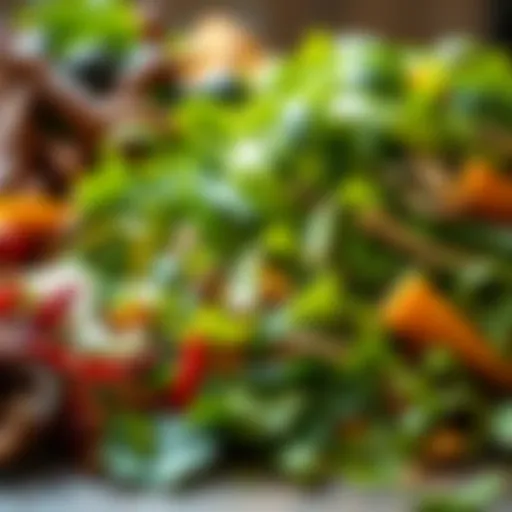Exploring Carrot Cake and Cream Cheese Frosting
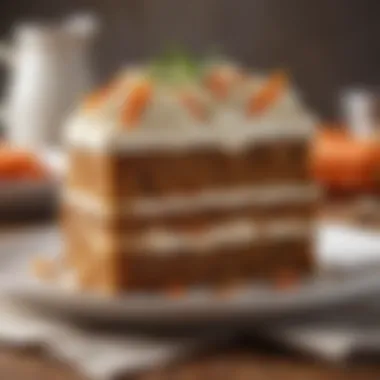
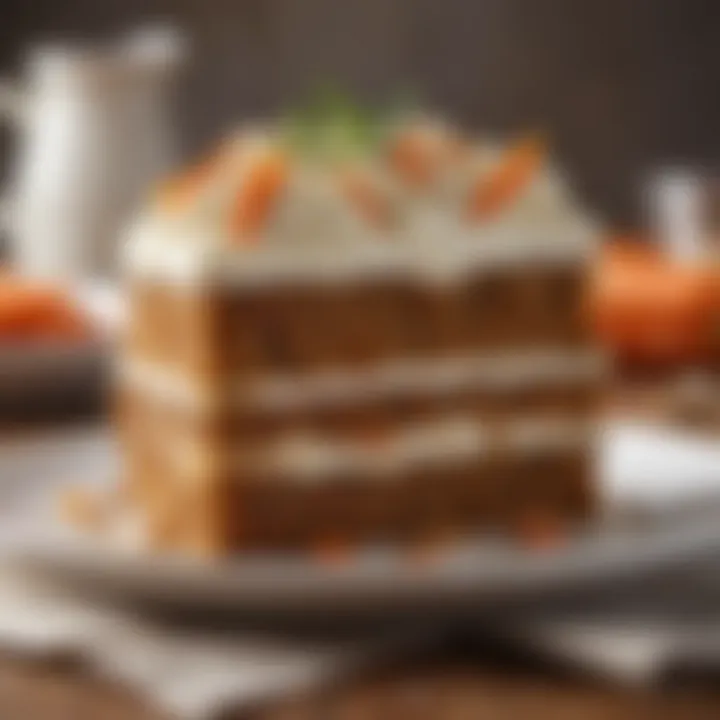
Intro
Carrot cake isn’t just a dessert; it’s a slice of history and culture baked into every crumb. Many people remember it fondly from their childhood, as it graced birthdays and family gatherings alike. But have you ever taken a moment to savor its origins, flavors, and what truly sets it apart from other cakes? This article dives into the depths of carrot cake, particularly when topped with the lusciousness of cream cheese frosting. By exploring its journey from humble beginnings to today's popular dessert, readers can appreciate the nuances of this beloved treat.
From the warmth of the kitchen to the gourmet cafés, carrot cake combines rich traditions with modern tweaks, making it accessible to food lovers of all ages. The balance of spices, complemented by the sweet, tangy cream cheese, delivers a unique palate experience that keeps people coming back for more. Let’s embark on this culinary journey with an in-depth look at the recipe, its key components, and the delightful variations that make carrot cake a classic.
Historical Context of Carrot Cake
Understanding the historical context of carrot cake provides a rich background for this beloved dessert. It reveals not only its origins and evolution but also the cultural significance that it carries in various cuisines around the world. Carrot cake is more than just a sweet treat; it's a connection to history, showcasing how ingredients and cooking methods have transformed over the centuries.
Origins in Medieval Europe
The notion of incorporating vegetables into cakes has roots stretching back to the medieval times in Europe. During this period, sugar was an expensive commodity, primarily accessible to the wealthy. In contrast, carrots were abundant and easily cultivated, making them a viable sweetening agent for desserts. In fact, some historians argue that carrot cake could be traced back to the carrot pudding, which gained popularity in England around the 18th century.
These early iterations of carrot desserts were much denser than the fluffy slices we see today and were often spiced with aromatic herbs. Unrefined sweetness from the carrots made them a practical alternative during times of sugar scarcity.
Evolution of the Recipe
Over time, the recipe for carrot cake evolved significantly, particularly in the mid-20th century. After World War II, ingredients became more readily available, and the cake transitioned from a simple, rustic dessert to a centerpiece of celebrations.
The typical carrot cake we know now, embellished with cream cheese frosting and often enhanced by flavors such as cinnamon and nutmeg, gained momentum in American kitchens. The 1960s marked a turning point as health trends began to influence baking. Cooks were more inclined to embrace the use of carrots not just for their sweetness but also for their nutritional value.
In the United States, the popularity of carrot cake soared, leading to its inclusion in various culinary books and slowly planting it firmly in the dessert canon.
"Carrot cake has transcended mere dessert; it's a testament to how a humble ingredient can transform through time into a recipe worthy of celebration."
To encapsulate, the historical journey of carrot cake from medieval Europe to contemporary kitchens is a fascinating narrative, reflecting agricultural practices, societal changes, and culinary creativity. Understanding this context aids in appreciating every slice of carrot cake topped with that luscious cream cheese frosting. It's not just a dessert; it’s a slice of history served on a plate.
In summary, the rich tapestry that gives carrot cake its robust identity is woven with elements of hardship, innovation, and communal experience, inviting us all to share and enjoy its delicious legacy.
The Importance of Ingredients
When it comes to whipping up a carrot cake with cream cheese frosting, the old adage rings true: you are only as good as your ingredients. The individual components play a critical role in not just the taste but also the texture and overall quality of the cake. Knowing what to look for makes all the difference in taking your cake from ordinary to extraordinary. So, let’s dig into the essential ingredients that contribute to the magic of this delightful dessert.
Choosing the Right Carrots
Carrots are the superstar of this cake, and their quality can make or break the dish. But not all carrots are created equal. Fresh, organic carrots are usually the best choice. They carry a naturally sweet flavor and a vibrant orange hue that can brighten up the cake. When selecting carrots, you're better off picking ones that are firm and have smooth skin, as these factors usually translate to better taste. Remember: the sweeter the carrot, the better the cake. Grating them finely allows them to integrate perfectly into the batter, ensuring that every bite is characteristically soft and moist.
"The foundation of any great dish begins with its ingredients. Choose wisely, and your cake will shine!"
The Role of Spices
Spices are the unsung heroes in your carrot cake recipe. They add depth and complexity, transforming this simple cake into a flavorful masterpiece. Ground cinnamon, nutmeg, and cloves are the common suspects here. These spices bring warmth and a cozy feeling, often evoking memories of home baking or holiday gatherings.
The trick is in balancing these flavors. Too much spice can overwhelm the cake, while too little can leave it flat. Start with a base of cinnamon, then adjust according to your palate’s preference. Some bakers even sneak in a bit of ginger or allspice for an extra layer of flavor. This creates an aromatic experience that delights the senses.
Selecting Quality Cream Cheese
A carrot cake simply isn't complete without a velvety cream cheese frosting. When it comes to cream cheese, don’t skimp on quality. The best frostings come from using full-fat cream cheese, which gives that rich, creamy texture we all love. Look for brands with simple, recognizable ingredients. Some cheaper alternatives may add fillers that detract from the smoothness and flavor.
Along with cream cheese, the right sweetener is vital. While powdered sugar is traditional, consider mixing it with a dash of vanilla extract for added richness. This combination amplifies the taste, making each forkful irresistible.
Decoding the Flavor Profile
Understanding the flavor profile of carrot cake with cream cheese frosting is akin to peeling the layers off an onion. Each layer reveals something deeper about the cake, contributing to its overall essence. When we talk about flavors in a dish, it’s the interplay of sweetness, spice, and texture that sets the stage for an unforgettable taste experience. In this section, we will delve into the nuances of sweetness against spice and the textural aspects that make carrot cake stand out.
Sweetness vs. Spice Balance
At its heart, carrot cake balances sweetness and spice beautifully. The sweetness comes primarily from the carrots and added sugars, while the warm spices—like cinnamon and nutmeg—infuse a contrasting zest that keeps the cake interesting. Here, finding the right balance is critical. Too much sweetness can drown out the flavors of the spices, while an overpowering spice can overshadow the cake's natural sweetness.
For instance, if a recipe leans heavily on granulated sugar without considering the other components, the result can be a one-note dessert that lacks depth. Conversely, overly aggressive spice can lead to a flavor profile that is potent but uninviting. Instead, the goal should be to achieve a harmonious relationship between these elements.
- Cinnamon is often the star, contributing both sweetness and warmth.
- Nutmeg adds an earthy undertone that deepens the flavor.
- A splash of vanilla extract can also elevate the flavors, rounding out the sweetness.
These elements can dance together—creating a cake that’s not just sweet but also rich in flavor complexities. A common suggestion is to start with less spice and adjust according to taste, as it's far easier to add than to take away. After all, nobody wants a cake that tastes like it jumped out of a spice jar! To make sure everything's in sync, a sample bite during baking can guide whether more sugar or spice is necessary.
Texture Considerations
Texture often goes hand-in-hand with flavor, especially in carrot cake, where cubes of moistness compete with the subtle crunch of nuts or the gentle fortitude of shredded carrots. When making carrot cake, achieving the right texture can feel like juggling balls; drop one, and everything tumbles down.
- Moistness is crucial, and this can be derived from the fresh grated carrots, eggs, and a bit of oil, which create a tender crumb. However, you don't want the cake to turn into mush.
- Introducing nuts adds a delightful crunch that contrasts beautifully against the moistness of the cake. Walnuts or pecans are popular choices that bring a combined richness and texture, while also complementing the spices with their own earthy flavor.
- Avoid overmixing when combining wet and dry ingredients; this can lead to a denser, tougher cake. Instead, fold gently until just combined to maintain some structural integrity in the batter.
A well-balanced carrot cake showcases a breadth of textures, from the soft, moist interior to the crumbly frosting that completes the experience. When paired with the cream cheese frosting—rich and mildly tangy—the flavors and textures meld exquisitely, inviting one bite after another.
By honing in on the sweetness versus spice balance and meticulously considering texture, the flavor profile emerges as a key player in elevating carrot cake to its beloved status.
"The essence of a recipe lies not only in its ingredients but in how they play off each other, harmonizing to create something that transcends its parts."
In summary, decoding the flavor profile of carrot cake requires attentiveness to the symphony of sweet, spice, and texture that brings this classic dessert to life.
Preparation Techniques
Preparation techniques play a crucial role in baking a successful carrot cake with cream cheese frosting. The difference between a moist, flavorful cake and a dry, bland one often boils down to how well the ingredients are handled throughout the process. Following a structured approach to preparation can enhance the overall quality of the cake, ensuring that each bite is a delightful experience.
Gathering Ingredients
Gathering ingredients is foundational in creating a carrot cake. The right selection can significantly influence the outcome, flavor, and texture of your cake. Here's what to consider:
- Fresh Carrots: Opt for organic carrots for the best flavor. These tend to have a more intense sweetness. Peel and finely grate them to ensure even distribution within the batter.
- Spices: Freshly ground spices such as cinnamon and nutmeg will contribute depth. Pre-ground alternatives often lack the rich aroma and flavor.
- Quality Cream Cheese: Ensure you get full-fat cream cheese, preferably from a reputable brand. It can vastly affect the cream cheese frosting texture and richness.
- Other Essentials: Flour, sugar, baking soda, eggs, oil, and vanilla extract round out the essential ingredients. Checking expiration dates is necessary to avoid any unwanted surprises!
In preparing your workspace, lay everything out so it's within arm's reach. Organizing your ingredients not only streamlines the process but also prevents mid-preparation chaos.


Mixing Process Explained
The mixing process is another pivotal step. It's where all those carefully selected ingredients come together to create a harmonious cake batter. Here are some pointers:
- Combine Dry Ingredients: Start with flour, baking soda, and spices in one bowl. Sifting them together helps aerate and insure even distribution.
- Wet Ingredients: In another bowl, blend the oil, eggs, and sugars, whisking vigorously until the mixture is smooth and creamy. This infuses air into the batter, helping your cake rise beautifully.
- Folding in Carrots: Cold grated carrots should be added last. Using a spatula, gently fold them into the wet ingredients. This ensures they’re evenly dispersed without losing the mix’s volume.
- Combining Both Mixtures: Gradually add the dry ingredients to the mixture of wet ingredients. Stir slowly to avoid overmixing; you want to keep that airy texture without developing gluten, which can make the cake dense.
Getting the mix right sets the stage for a successful bake. Each step here contributes to moisture and texture, defining the ultimate success of your carrot cake.
Baking Instructions
Proper baking instructions are essential for achieving that golden-brown exterior while keeping the inside tender and moist. Here’s a straightforward guide:
- Preheat the Oven: Start at 350°F (175°C). It’s crucial to allow the oven to reach the right temperature before the cake goes in.
- Prepare Your Pan: Greasing the pan with butter or oil and lining it with parchment paper saves you the hassle of a stuck cake.
- Pouring the Batter: Generate a gentle swirl while pouring the batter into the pan for even spreading. Don’t overfill; two-thirds full is ideal to allow room for rising.
- Baking Duration: Generally, your cake will need around 25 to 35 minutes. Use a toothpick to check for doneness — it should come out clean.
- Cooling Down: After baking, allow the cake to cool in the pan for about 10 minutes. Transfer it gently to a wire rack to cool completely before frosting.
Making the effort here pays off when you slice into your cake. The correct baking techniques yield a delightful sensation that resonates with anyone who takes a bite, making every moment spent in the kitchen worthwhile.
The art of preparing carrot cake is a journey from gathering ingredients to the final bake, culminating in a dessert that is more than just cake; it's a loving embrace of flavors.
Frosting Methodology
The methodology behind frosting, particularly the beloved cream cheese frosting for carrot cake, is integral to achieving not just aesthetic appeal, but also a pleasing balance of flavors and textures. This part of the culinary process can elevate an otherwise ordinary cake into a masterpiece. Understanding how to create and apply frosting effectively is essential for both novice bakers and seasoned professionals.
Key elements to consider include the consistency of the frosting, the flavors that complement the cake, and the techniques used to apply it. The right frosting can complement the moistness of the cake, adding a rich, tangy contrast to the sweetness of the carrots and the spices within. Moreover, applying the frosting in a thoughtful manner ensures that each slice of cake delivers a harmony of flavors.
Creating the Cream Cheese Frosting
To craft a delightful cream cheese frosting, it's essential to focus on quality ingredients and precise technique. Here’s a breakdown of what you’ll need:
- Ingredients:
- 8 oz cream cheese, softened
- 1/2 cup unsalted butter, softened
- 4 cups powdered sugar
- 1 tsp vanilla extract
Steps:
- In a large mixing bowl, blend the softened cream cheese and butter together until they form a smooth, creamy mixture. This may take a couple of minutes. You want it velvety.
- Gradually add the powdered sugar to the mix. It’s wise to do this slowly to avoid a cloud of sugar dust. It may look a bit grainy at first, but don't fret—it will come together.
- Once smooth, mix in the vanilla extract, which not only enhances the flavor but also complements the overall profile of the cake.
- For a thicker consistency, add a bit more powdered sugar. If you prefer a lighter topping, you can adjust the butter slightly.
It's worth noting that the temperature of your ingredients matters. If your butter and cream cheese are too cold, you could end up with lumps in your frosting, detracting from that silky texture you’re aiming for.
Application Techniques
Applying cream cheese frosting is as much an art as it is a science. There are a few techniques that can make your frosting application not only easier but also visually appealing:
- Crumb Coating: Start with a thin layer of frosting, called a crumb coat, around the cake. This will seal in the crumbs that may otherwise mix in with the final layer of frosting.
- Offset Spatula Use: Using an offset spatula allows for easier and smoother spreading of the frosting. Apply a generous amount on the top of the cake, then spread it over to the sides.
- Pipe for Design: If you want to get fancy, using a piping bag can create delightful borders or other patterns on the cake. This not only adds to visual appeal but can create different textures as well.
- Consider Layering: For those who enjoy multi-layered carrot cakes, don’t forget to evenly frost between each layer before centering everything together.
"The frosting might just be the glue that holds the cake together, but it’s also what makes it unforgettable."
Decorative Elements
When it comes to carrot cake with cream cheese frosting, the aesthetic presentation plays a pivotal role. Decorative elements are not merely for show, but they add to the experience of enjoying this delightful dessert. A well-decorated cake can elevate the overall impression during special occasions, making each slice feel like a piece of art. Beyond mere looks, these elements can also influence taste perceptions and set the stage for memorable gatherings.
Ideas for Garnishing
Finding the right garnishes can turn a humble carrot cake into a centerpiece worthy of admiration. Here are some unique ideas for garnishing your carrot cake:
- Candied Carrots: Slice carrots thinly, boil them in sugar water, and let them cool. The bright orange color against the pale cream cheese frosting brings freshness.
- Nuts: Chopped walnuts or pecans sprinkled on top can add a delightful crunch, contrasting beautifully with the soft frosting.
- Edible Flowers: Flowers like pansies or violets can add a touch of elegance. They’re particularly lovely for spring celebrations.
- Coconut Flakes: Toasted coconut flakes not only add flavor but also a tropical twist that complements the spices in the cake.
- Chocolate Shavings: For chocolate lovers, a sprinkle of dark chocolate shavings can introduce a richer flavor balance.
Each of these options not only enhances visual appeal but also introduces various textures and tastes that can enthrall the palate.
Presentation Techniques
How you present your carrot cake can make all the difference. Here are some straightforward yet effective presentation techniques:
- Layered Presentation: If you choose to make a multi-layered cake, consider sharing a slice to display those lovely layers of cake and frosting. This adds depth and excitement when someone cuts into it.
- Cake Stands: Use a pedestal cake stand to elevate your cake—literally and figuratively. Height can create a striking visual effect on the table.
- Plating: Serve slices on plates with a drizzle of icing or a sauce made from pureed fruits like raspberry or passionfruit. This adds another visual layer while also enhancing flavor.
- Slice Arrangement: When serving at a gathering, arrange the slices in a circular or fan pattern around the cake, allowing guests easy access and creating an inviting display.
- Garnish Touches: Use small sprigs of mint or tiny edible flowers to garnish each individual slice. It adds a touch of sophistication and shows attention to detail.
"Presentation matters—people eat with their eyes first!"
By carefully considering decorative elements and presentation techniques, you will not only impress your guests but also create a delightful experience that enhances the enjoyment of your carrot cake.
Variations of Carrot Cake
When considering carrot cake, the traditional recipe might spring to mind, featuring moist layers accentuated by cream cheese frosting. However, variations of carrot cake are worth exploring. These adaptations not only offer delightful twists, but they also cater to diverse taste preferences and dietary needs. By venturing beyond the classic, bakers can infuse creativity and personal touches into their cakes, making the experience of carrot cake even more enjoyable.
Incorporating Nuts and Fruits
One of the most popular tweaks to the classic recipe is the addition of nuts and fruits. Nuts, such as walnuts or pecans, can provide a crunch that perfectly balances the soft texture of the cake. They also contribute an earthy flavor that complements the sweetness of the carrots.
Conversely, fruits can introduce additional moisture and unique flavors. Pineapple is a favorite among many bakers for its natural juiciness, but dried fruits, such as raisins or cranberries, can also work wonders. They add unexpected bursts of sweetness that can really elevate a slice of carrot cake.
These inclusions are not merely a random sprinkle; they should harmonize with the overall flavor profile. Here are some considerations:
- Choose nuts with care: Walnuts have a rich, buttery flavor, while pecans present a slightly sweeter profile. Consider users' preferences and dietary restrictions, as nuts may not be suitable for everyone.
- Use fruits wisely: Fresh fruits can increase moisture drastically. Opting for a smaller portion could avoid an overly soggy cake.
Experimenting with these variations brings depth to the flavor and texture of the cake and can also make a beautiful presentation when garnished atop.
Gluten-Free Adaptations
Recently, the demand for gluten-free adaptations has surged, allowing those with dietary restrictions to enjoy carrot cake. Thankfully, the core ingredients of carrot cake are compatible with gluten-free substitutes. For a successful gluten-free carrot cake, bakers can replace all-purpose flour with almond flour, coconut flour, or a dedicated gluten-free flour blend.
In adjusting the recipe, here are some key points to consider:
- Moisture is crucial. Gluten-free flour can absorb more liquid than regular flour. Thus, increasing ingredients like oil or eggs or adding applesauce can retain moisture, ensuring the cake doesn’t become dry.
- Balancing flavors. Gluten-free flours have distinct tastes. Almond flour lends a nutty flavor, while coconut flour provides a hint of sweetness. Doing this can complement the overall taste or surprise eaters positively.
Adapting recipes to be gluten-free not only offers inclusivity but allows for innovation in flavor and texture. These variations ensure a wider audience can appreciate the delights of carrot cake with cream cheese frosting, maintaining the essence of this cherished dessert.
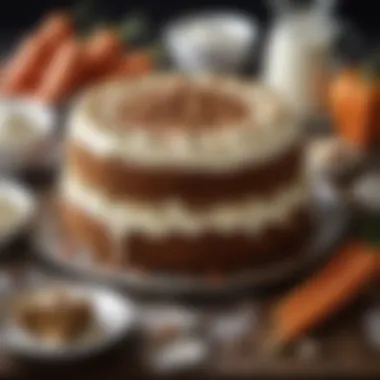
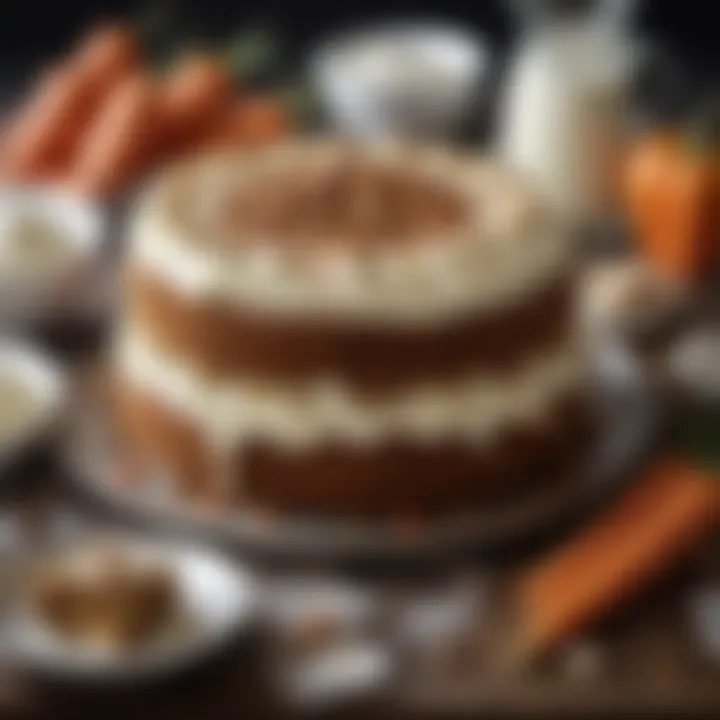
Nutritional Aspects
The nutritional aspects of carrot cake with cream cheese frosting might not pop into everyone’s mind when they indulge in a slice, but understanding what’s in it can really enhance our appreciation for this delightful dessert. There’s more to this cake than just sugar and flour. Each ingredient carries weight in terms of both health benefits and calorie contribution. This section will shine a light on the caloric breakdown of our beloved carrot cake and explore the health benefits that come from its vibrant ingredients.
Caloric Breakdown
When considering any dish, especially desserts, being aware of the caloric intake is important. A typical slice of carrot cake with cream cheese frosting can clock in at around 350 to 500 calories. This can vary quite a bit based on the recipe and the portion size. For those who keep an eye on their dietary habits, it can be quite helpful to break this down further:
- Carrots: While often overlooked, carrots contribute to the sweetness while adding a modest number of calories, about 30-40 calories per 100 grams.
- Sugar: The sugar can usually account for a hefty chunk, often contributing 200 calories or more in a typical slice.
- Flour: All-purpose flour generally adds around 100 calories per 30 grams, which is common in most cake recipes.
- Cream Cheese Frosting: This frosting, particularly if generous, adds quite a bit—often around 100-200 calories more per slice.
So, when you think about it, those slices stack up quickly. It’s worth remembering that a little indulgence now and then doesn’t hurt, but every slice does come with its calorie baggage.
Health Benefits of Ingredients
Digging deeper into the ingredients, carrot cake can actually have some surprising health benefits, thanks to its wholesome components. Here are some crucial points to ponder:
- Carrots: It might sound cliché, but carrots are a powerhouse of nutrition. They’re packed with beta-carotene, which the body converts into vitamin A, supporting eye health and immune function.
- Spices: Common spices used, like cinnamon and nutmeg, not only make the cake taste great but also come with antioxidant properties. Cinnamon, for instance, has been linked to lower blood sugar levels and improved heart health.
- Nuts: If you incorporate walnuts or pecans into the mix, you’re adding healthy fats, protein, and fiber, not to mention vitamins and minerals. They also lend a delightful crunch to the texture.
- Eggs: Typically found in carrot cake, eggs are excellent sources of protein and nutrients like Vitamin D and B12. They contribute to both the richness and nutritional qualities of the cake.
Remember: Balance is crucial. Savoring a slice of carrot cake can actually blend enjoyment and nutrition if one keeps an eye on portion sizes and considers the quality of ingredients used.
Cultural Significance
The cultural significance of carrot cake, especially paired with cream cheese frosting, transcends mere taste. This dessert represents a fusion of history, creativity, and celebration across various cultures. It has woven itself into the fabric of festive occasions, where it shows up at birthdays, weddings, and even casual family gatherings. By examining its role in popular cuisine and traditions surrounding its preparation, we gain insight into why this cake continues to be cherished.
Carrot Cake in Popular Cuisine
Carrot cake has carved out a respected place in the culinary world, often categorized alongside other popular staples like chocolate and vanilla cakes. It often surprises people that a dish that originally rose from humble beginnings could become an iconic dessert. Today, carrot cake is commonly featured in bakeries and restaurants, often adorned with delightful variations that reflect local tastes and preferences.
Its fame can be tied to the versatility in flavor and texture it offers, bringing together sweet, spiced, and creamy elements in each bite. Traditionally adorned with walnuts or pecans, this cake can be altered to include other ingredients like pineapple or coconut for added moistness and flavor.
Many people enjoy this cake not just for its taste, but also the nostalgic feelings it evokes from childhood celebrations. This type of cake harks back to simpler times, where family and friends gathered around the table to share homemade delights.
"Carrot cake serves as a canvas for culinary creativity, allowing bakers to express individuality while retaining the essence of a classic dessert."
Traditions Surrounding Cake-Baking
The act of baking carrot cake can be seen as an intimate ritual shared among family and friends. From grandma's kitchen to modern bakeries, the tradition has stayed alive, with each generation adding its personal touch. Often, these baking sessions become a catalyst for bonding, with laughter and stories shared over mixing bowls and measuring cups.
In many cultures, certain occasions are deemed incomplete without a cake. For instance, during Easter, carrot cake serves as a nod to the coming spring and an embodiment of renewal. It’s heartwarming to see how communities embrace this dessert in their festive customs, each putting a unique spin based on local flavors.
Baking also reflects the cultural identity of a community. Recipes may vary significantly from one country to another depending on ingredient availability and local preferences. Notably, the influence of baking a carrot cake can serve as a bridge across cultures, connecting various culinary practices while promoting the joy of sharing between neighbors and loved ones.
In summary, the cultural significance of carrot cake with cream cheese frosting lies in its rich heritage and continued evolution within contemporary cuisine. With each bite, it carries a legacy of tradition, love, and festivity, making it much more than simply a dessert.
Common Mistakes to Avoid
When embarking on your carrot cake journey, knowing what pitfalls to dodge can save you a heap of trouble down the line. Perfecting this sweet delight isn't just about following the recipe; it involves understanding the nuances that go into baking and frosting. Here, we delve into potential mistakes that can ruin your cake or frosting, helping you achieve that perfect slice every time.
Baking Errors
Baking a carrot cake requires precision and attention to detail. A common misstep is overmixing the batter. It’s tempting to whip it until it’s silky smooth, but doing so can lead to a dense, less appealing texture. Instead, mix just until the ingredients combine; a few lumps are perfectly fine.
Another frequent error is underbaking the cake. Each oven is a law unto itself. The recipe might suggest a baking time, but do take the time to check for doneness with a toothpick. If it comes out clean, you’re golden; if it’s gooey, it needs more time.
Also, be mindful of your oven temperature. If it runs hot, your cake could burn before it’s fully baked. Likewise, placing your cake too high or low can cause uneven baking. Ideally, the center rack is the sweet spot.
"Baking is an art – be attentive, and your cake will reward you!"
Frosting Failures
Let’s not forget about the cream cheese frosting, which is as crucial to your carrot cake as the cake itself. A common blunder is using cold cream cheese straight from the fridge. The key to a smooth frosting is to let it soften at room temperature before you start mixing. Cold cream cheese will cause lumps, and you’ll be left with more frustrations than sweetness.
Another miscalculation occurs with the sugar ratios. Adding too much powdered sugar can make it overly sweet and unmanageable. Gradually incorporate the sugar, tasting as you go. Don’t forget, you can always add more, but it’s tough to take it away once it's in there.
Lastly, some folks neglect to account for the humidity of their environment, which can affect the consistency of the frosting. On a humid day, you might need to add a touch more sugar to stabilize it, while drier air might require a bit of milk to soften.
Avoiding these common pitfalls will give you a solid foundation in creating not just a carrot cake, but a memorable experience with every bite.
Storage and Shelf Life
When digging into the delightful realm of carrot cake with cream cheese frosting, one crucial topic stands out: how to store this decadent dessert properly. The freshness of a cake, especially one with a rich creamy topping, can make all the difference between a pleasant experience and a disappointing one. Understanding the best practices around storage and shelf life ensures not just longer enjoyment but also the preservation of quality and taste.
Why Is Storage Important?
Getting the storage right is key, especially for carrot cake, as it contains moist ingredients and cream cheese, which can compromise its safety and flavor if neglected. Proper storage can help prevent spoilage, drying out, or the development of unwanted flavors. Plus, it maximizes enjoyment for when you’re ready to indulge.
Best Practices for Storage
Storing carrot cake might seem straightforward, but there are nuances worth noting for keeping both the cake and the frosting in pristine condition. Here are some basic yet effective practices:
- Cool Completely: Before you even think about storage, give your cake ample time to cool. Wrapping a warm cake can lead to condensation and sogginess, defeating the purpose of a well-baked dessert.
- Use Airtight Containers: Invest in good quality airtight containers. This not only keeps your cake fresh longer but also protects it from other odors in the fridge. If you don’t have one handy, you can wrap your cake loosely in plastic wrap.
- Slice Wisely: If you intend to eat your cake over several days, slice pieces as needed. Each cut exposes the interior, and the less air that reaches it, the longer your cake will stay fresh.
- Chill the Frosting: Cream cheese frosting can be prone to melting if left out. If you're not serving right away, keep the whole cake in the fridge, or at least the frosting part, especially in warmer weather.
By observing these practices, you can ensure that your carrot cake remains tantalizingly moist and flavorful, ready to delight each time you reach for a slice.
Freezing Techniques
Sometimes, you may find yourself with a surplus of carrot cake, or perhaps you want to prepare it ahead of time. In such cases, mastering freezing techniques is essential. Here’s how you can freeze your stellar creation without sacrificing quality:
- Wrap it Up: Just like with storage, you’ll want to wrap your carrot cake well. Consider using several layers of plastic wrap followed by aluminum foil to block out the air completely. This will prevent freezer burn, which can be a real party crasher.
- Pre-Slice If You Like: If you prefer to take out only a piece at a time, pre-slicing the cake is an intelligent approach. Just ensure to wrap each slice individually in plastic before placing them in a larger container or freezer bag.
- Labeling is Key: Don’t forget to label your frozen cake with the date. It’s easy to forget, and knowing when you froze it can help you decide when to toss if it’s been too long. Ideally, carrot cake can last up to three months in the freezer.
- Thawing: When you’re ready to devour your cake again, move it from the freezer to the fridge. Allow it to thaw overnight for the best results. If you’re in a rush, you can leave it out at room temperature for about an hour, but be prepared for a slight loss in texture and moisture.
"Proper storage and freezing techniques can extend the life of your carrot cake while preserving its deliciousness."
With these tips under your belt, you can enjoy your homemade carrot cake with cream cheese frosting, knowing it will be just as scrumptious on the second or even third day—or after a freezing interlude.
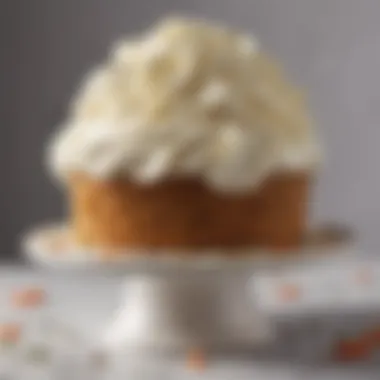
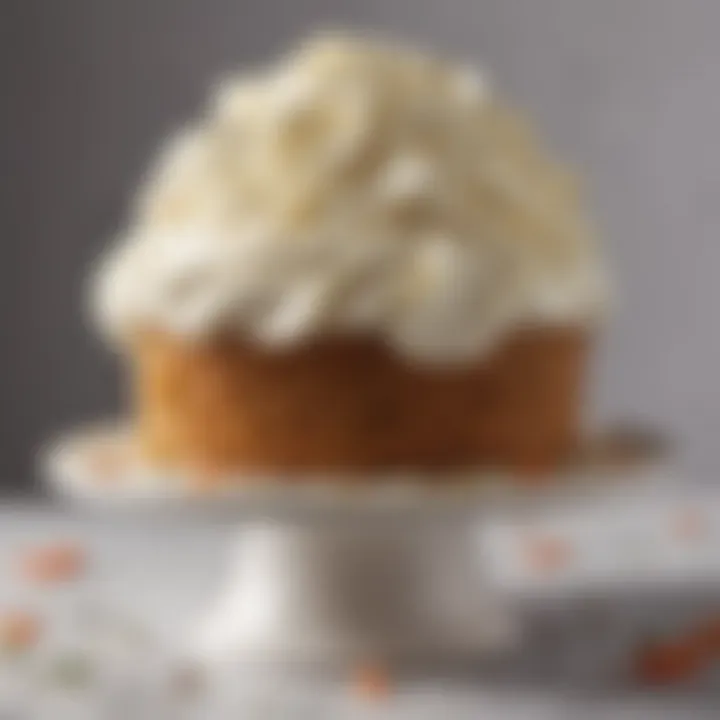
Serving Suggestions
Effective serving suggestions elevate the carrot cake experience, bringing forth its flavors in the best light. It’s not just about presentation; it’s about creating a multi-sensory experience that resonates with the audience. Here, we delve into pairing beverages and enhancing flavors with accompaniments that are sure to impress any cake lover.
Pairing Beverages
The choice of beverage can significantly influence how one enjoys carrot cake. Here are some popular drink options that complement its rich and spiced flavors:
- Tea: A pot of hot Earl Grey or a spiced chai can provide a fragrant counterpart to the cake’s complexity. The subtle astringency of tea cuts through the creaminess of the frosting nicely.
- Coffee: A cup of freshly brewed coffee, particularly a dark roast, offers a bold flavor that contrasts beautifully with the sweetness of the carrot cake, making every bite a delightful experience.
- Wine: Dessert wines like late harvest Riesling or a sweet Sauternes work well with carrot cake's natural sweetness, while ensuring the spice doesn’t overshadow the drink.
- Milkshakes: A rich vanilla milkshake can pair excellently, especially for a more casual presentation. The cold, creamy texture enhances the sweetness of the frosting.
Pairing the right beverage with your carrot cake not only enriches the overall experience but also provides a delightful contrast that enhances its flavors. Each sip of the drink chosen can bring out different notes in the cake, creating a dance of taste on the palate.
Accompaniments to Enhance Flavor
To truly make your carrot cake memorable, consider adding some carefully chosen accompaniments. Here’s a list of options that can complement your dish:
- Nuts: Chopped walnuts or pecans can add a crunchy texture that contrasts with the soft cake and creamy frosting. They can be sprinkled on top or served alongside.
- Fresh Fruit: Slices of fresh orange or pineapple can provide a zesty brightness, balancing the dense sweetness of the cake with a refreshing note.
- Dried Fruits: Consider offering dried cranberries or raisins as a side that can add a chewy and tart counterpoint.
- Ice Cream: A scoop of vanilla or spiced ice cream can add a luscious creaminess which complements the frosting beautifully, creating a dessert that is simply divine.
By pairing your carrot cake with the right drinks and accompaniments, it turns an ordinary slice into a delightful culinary moment. Whether it’s for a birthday party or a casual afternoon tea, a well-thought-out serving plan can make all the difference.
Remember: The goal is to create harmony on the plate and in the glass, enhancing every element of this beloved dessert.
Exploring Regional Variants
Regional variations of carrot cake provide a fascinating glimpse into how a simple dessert can evolve based on cultural nuances and local ingredients. This section helps highlight the importance of embracing diverse styles, which ultimately enriches our culinary tapestry. Understanding these regional variants offers more than just recipes; it unveils unique traditions, preferred flavors, and varying methods of preparation that each culture brings to the table. By exploring these different interpretations, one can appreciate not only the versatility of carrot cake itself but also how our tastes can be shaped by geography and cultural history.
Traditional Recipes from Different Cultures
Carrot cake might appear straightforward, but different cultures have put their own unique spin on the classic. In the UK, for instance, carrot cake often includes a layer of marzipan or a drizzle of icing, making it more festive. It's common to see moist, dense cakes topped with walnuts and adorned with cream cheese frosting that is extra thick. The ingredient choices reflect both local palates and seasonal availability, as carrots could be harvested into late autumn.
In contrast, Middle Eastern versions might incorporate spices like cardamom and nutmeg, intertwining the carrot base with a rich tapestry of flavors. Drenched in syrup with a sprinkle of pistachios, these carrot cakes tell a story of indulgence and warmth, not often found in Western interpretations.
Furthermore, in Asia, variations might include coconut or even tropical additions like pineapple, which would definitely brighten up the cake's flavor with a sweet burst. These adaptations respect local preferences while keeping the essence of carrot cake alive.
- Key elements of regional traditional recipes include:
- Local ingredients often highlight seasonal produce.
- Unique spices that speak to the culture's palate.
- Variations in frosting or filling that reflect local traditions.
With every slice enjoyed, the person savoring the cake tastes not just the dessert but also the history and culture that came together to make it.
Modern Takes on Carrot Cake
Modern interpretations of carrot cake show just how inventive bakers can be when drawing from tradition. Chefs today might utilize alternative flours like almond flour or coconut flour for a gluten-free option while still maintaining a satisfying bite. Creative minds have even taken to adding unexpected ingredients—like zucchini or apples—to amp up the moisture and texture. The flavor profile shifts, and with it, the nutritional value.
Some contemporary recipes emphasize a health-conscious approach, combining natural sweeteners such as maple syrup instead of sugar, which could appeal to a broader audience. Health enthusiasts might even opt for a vegan rendition, swapping out eggs and butter for bananas or flaxseed. This opens up avenues of discovery for those who might have dietary restrictions yet still wish to partake in the pleasures of carrot cake.
Signature toppings have also forever transformed this dessert; consider a spiced ginger cream or a lemon-infused frosting that provides an unexpected tang. The beauty of modern takes is in their adaptability, allowing for a playful and experimental kitchen atmosphere.
- Important elements of modern adaptations might include:
- Use of alternative sweeteners like agave syrup or stevia.
- Alternatives to eggs and dairy, making it vegan-friendly.
- Incorporation of superfoods, such as chia seeds or flaxseeds.
These innovations showcase how carrot cake continues to evolve while respecting its roots, bridging the gap between tradition and today’s culinary creativity.
“Baking is both an art and a science. Each culture adds its brush strokes to create a masterpiece that is not only tasty but meaningful.”
By appreciating the variations in recipes across cultures and time, we recognize that carrot cake is more than merely a dessert; it serves as a canvas reflecting the stories and flavors from around the world.
Carrot Cake for Special Occasions
Carrot cake is not just any dessert; it holds a special significance in various celebrations, often seen as the life of the party. This dessert, with its moist texture and delightful spices, brings a warmth that resonates well with various festivities. The combination of carrot cake and cream cheese frosting is a match made in culinary heaven, making it a household favorite during significant events. By understanding its role in special occasions, we can appreciate how it enhances gatherings and creates lasting memories.
Birthdays and Celebrations
When it comes to birthdays and social gatherings, the choice of cake can make or break the festive spirit. Carrot cake shines in this regard. Luminescent with vibrant orange and adequately frosted, it’s an eye-catcher. Not only does it appeal to the taste buds, but it also adds a touch of charm to birthday parties.
- Versatility: One of the main reasons behind its popularity on birthdays is versatility. Carrot cake can be made in various forms—layered, sheet, or even cupcakes. The adaptability of the recipe accommodates different preferences, ensuring everyone finds joy in a slice.
- Flavor Balance: The balance of sweetness against the spice of cinnamon and nutmeg gives it a rich flavor that's often a crowd-pleaser. People of all ages can savor it. It caters to those who prefer a nuanced taste rather than an overtly sugary dessert.
- Personal Touches: Carrot cake also allows for personal touches. From adding walnuts or raisins to customizing the frosting, bakers can tailor the dessert to reflect the individual tastes of the birthday honoree, making it a unique part of the celebration.
Weddings and Formal Events
Weddings and formal events often call for elaborate, majestic cakes. Yet, carrot cake can elegantly step into this realm. Its rustic charm blended with sophistication allows it to fit perfectly into such settings.
- Cohesive Theme: A carrot cake can be a great element to reinforce the decor theme. Whether the wedding is rustic or traditional, the natural colors of carrot cake paired with white cream cheese frosting can tie together centerpieces beautifully. This dessert can be as elaborate or simple as desired, matching the couple's unique style.
- Deliciously Unique: Including carrot cake at a formal gathering like a wedding can make it stand out among traditional options like vanilla or chocolate. Guests will appreciate a cake that’s a tad bit different yet still familiar, igniting conversations and sparking curiosity.
- Bespoke Possibilities: With couples now seeking ways to represent their personal stories, carrot cake serves as a canvas for creativity. From floral decorations atop the cake to decorative glazes that tell a story, it can be personalized in myriad ways, capturing the essence of the day.
"A carrot cake at a wedding isn't just a dessert; it symbolizes a blend of tradition and modernity—offering a taste of love served on a plate."
Epilogue
In wrapping up the journey through the art and science of carrot cake with cream cheese frosting, it’s essential to underline several key elements that this article has explored. The beauty of carrot cake lies not just in its taste but in its rich tapestry of history and cultural significance. From its roots in medieval cuisine to contemporary adaptations, this delectable dessert encapsulates a broad spectrum of flavors and textures that delight palates worldwide.
One significant point that stands out is the crucial role of high-quality ingredients. Whether it’s the freshness of the carrots or the creaminess of the cheese, the choice of ingredients fundamentally shapes the final product. In addition, we’ve discussed various preparation and decorating techniques that can elevate a simple cake into a show-stopping centerpiece for any occasion. The discussion of nutritional aspects also highlights a deeper appreciation for the cake, as many might overlook its potential health benefits hidden within those ingredients.
Most importantly, this article serves as an invitation for readers to embrace their culinary creativity. Exploring the realms of carrot cake not only taps into history and tradition but also encourages innovation. This cake can easily be tailored to fit the dietary needs or flavor preferences of family and friends.
In essence, a carrot cake, especially with cream cheese frosting, is more than just a dessert; it’s a delicious exploration of culture, creativity, and nourishment that brings people together.
Recapping Key Points
- Historical Roots: Carrot cake has a fascinating background, stemming from medieval practices and adapting over centuries.
- Ingredient Importance: High-quality ingredients like fresh carrots and good cream cheese are pivotal.
- Flavor Balance: A successful carrot cake features a harmonious blend of sweetness, spice, and texture.
- Culinary Techniques: Various methods of preparation and decoration can enhance the cake's aesthetic and flavor.
- Health Benefits: Recognizing the nutritional aspects can deepen one’s appreciation of this dessert.
- Regional Variations: The dessert adapts to different cultures, offering unique spins that are worth exploring.
Encouragement for Culinary Exploration
Now is the time to roll up your sleeves and dive into your own culinary adventures with carrot cake and cream cheese frosting. Whether you’re an experienced baker or just getting your feet wet, there’s immense satisfaction in crafting this classic dessert from scratch. You might be surprised at how enjoyable the process can be, from grating the carrots to whipping up that frosting just right.
Experimentation is the name of the game. Don’t hesitate to swap in your beloved spices or add unexpected ingredients, like pineapple or coconut. Each attempt brings its own unique spin, and who knows? You could stumble upon your own signature version that dazzles friends and family.
Furthermore, engaging with communities of food lovers can enhance your journey. Websites like Reddit offer forums for sharing experiences and gathering tips, while social media platforms like Facebook can help you connect with fellow baking enthusiasts.
The world of baking is vast and varied, so take the plunge and explore the many interpretations of carrot cake. The rewards go far beyond crafting a beautiful cake—it's about the memories created, the smiles shared, and the delight of trying something new. Happy baking!





